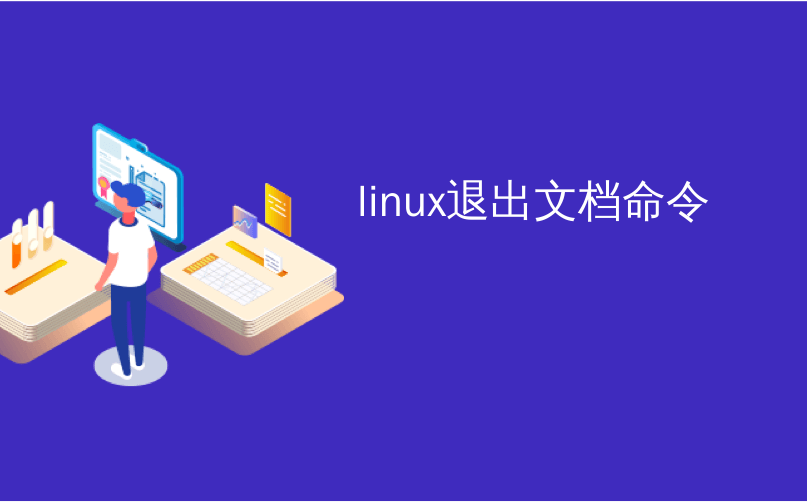
linux退出文档命令
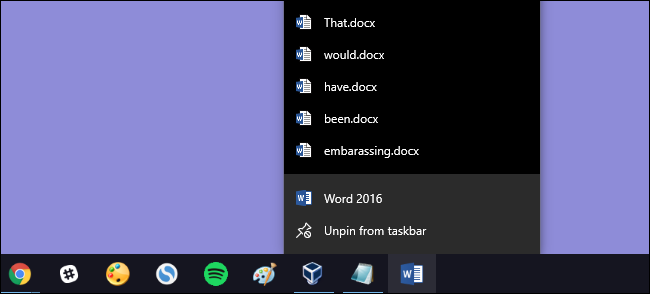
You never know when that “Recent Documents” jump list will come back to bite you. Maybe you share your user account with other people, or maybe you’re just really cautious. Your reasons are your own. We’re just here to show you how to make sure it clears every time you shut down.
您永远都不知道何时“最新文档”跳转列表会再次咬住您。 也许您与其他人共享您的用户帐户,或者您只是非常谨慎。 你的原因是你自己的。 我们只是在这里向您展示如何确保每次关闭时清除它。
With a quick Registry or Group Policy edit, you can have Windows automatically clear the recent documents list every time you exit Windows. That list includes recent files shown in File Explorer, as well as on your apps’ jump lists—whether those apps are on the Start menu or pinned to the taskbar. We’ve talked before about how to turn off recent items in Windows, and even how to clear a single jump list if that’s all you need to do. So what’s the difference here? The hack we’re covering in this article allows you to continue using the recent items list normally up until you exit Windows by restarting or shutting down your PC, or by signing out of your account.
通过快速的注册表或组策略编辑,您可以让Windows每次退出Windows时自动清除最近的文档列表。 该列表包括“文件资源管理器”中显示的最新文件,以及应用程序的跳转列表中的最新文件-这些应用程序是在“开始”菜单上还是固定在任务栏上。 我们之前已经讨论过如何在Windows中关闭最近的项目,以及如果需要的话甚至如何清除单个跳转列表。 那么这里有什么区别? 我们在本文中介绍的黑客使您可以正常地继续使用最近使用的项目列表,直到通过重新启动或关闭PC或退出帐户退出Windows为止。
家庭用户:通过编辑注册表清除“最近文档”列表 (Home Users: Clear the Recent Documents List by Editing the Registry)
If you have a Windows Home edition, you will have to edit the Windows Registry to make these changes. You can also do it this way if you have Windows Pro or Enterprise, but feel more comfortable working in the Registry than Group Policy Editor. (If you have Pro or Enterprise, though, we recommend using the easier Group Policy Editor, as described in the next section.)
如果您使用的是Windows Home版本,则必须编辑Windows注册表才能进行这些更改。 如果您拥有Windows Pro或Enterprise,也可以通过这种方式进行操作,但是与组策略编辑器相比,在注册表中进行操作会更自在。 (但是,如果您具有Pro或Enterprise,我们建议使用更简单的组策略编辑器,如下一节所述。)
Standard warning: Registry Editor is a powerful tool and misusing it can render your system unstable or even inoperable. This is a pretty simple hack and as long as you stick to the instructions, you shouldn’t have any problems. That said, if you’ve never worked with it before, consider reading about how to use the Registry Editor before you get started. And definitely back up the Registry (and your computer!) before making changes.
标准警告:注册表编辑器是一个功能强大的工具,滥用它会使您的系统不稳定甚至无法运行。 这是一个非常简单的技巧,只要您按照说明进行操作,就不会有任何问题。 也就是说,如果您以前从未使用过它,请在开始之前考虑阅读有关如何使用注册表编辑器的信息。 并在进行更改之前一定要备份注册表(和您的计算机!)。
To get started, open the Registry Editor by hitting Start and typing “regedit.” Press Enter to open Registry Editor and give it permission to make changes to your PC.
首先,点击开始并键入“ regedit”,打开注册表编辑器。 按Enter键打开注册表编辑器,并授予其对PC进行更改的权限。

In the Registry Editor, use the left sidebar to navigate to the following key:
在注册表编辑器中,使用左侧边栏导航至以下键:
HKEY_CURRENT_USER\SOFTWARE\Microsoft\Windows\CurrentVersion\Policies\Explorer\
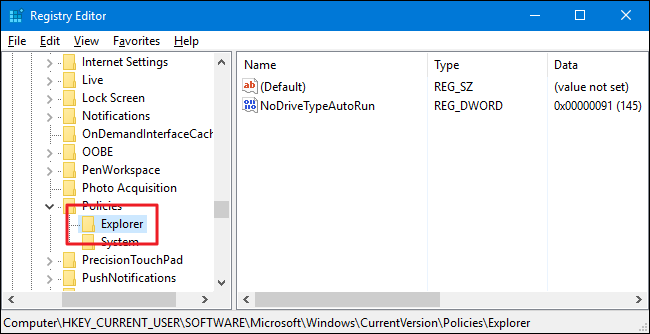
Next, you’re going to create a new value in the Explorer key. Right-click the Explorer key and choose New > DWORD (32-bit) Value. Name the new value “ClearRecentDocsOnExit.”
接下来,您将在Explorer键中创建一个新值。 右键单击Explorer键,然后选择“新建”>“ DWORD(32位)值”。 将新值命名为“ ClearRecentDocsOnExit”。
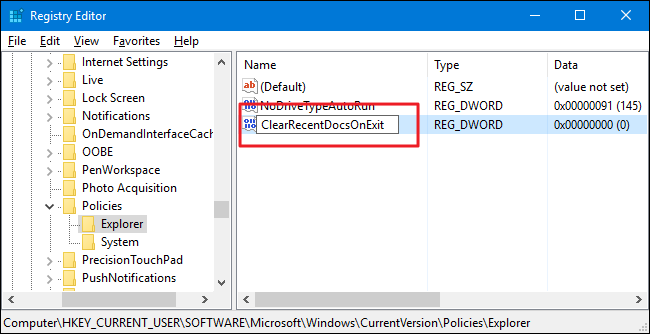
Double-click the new ClearRecentDocsOnExit value to open its properties window. Change the value from 0 to 1 in the “Value data” box and then click “OK.”
双击新的ClearRecentDocsOnExit值以打开其属性窗口。 在“数值数据”框中将值从0更改为1,然后单击“确定”。
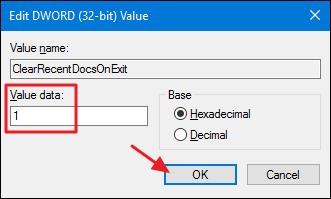
You can now close Registry Editor. The next time you sign out of your user account, or shut down or restart your PC, your recent documents will be cleared. To reverse the change, just follow the same steps and set the ClearRecentDocsOnExit value back to 0.
现在,您可以关闭注册表编辑器。 下次您退出用户帐户,或者关闭或重新启动PC时,您最近的文档将被清除。 要撤消更改,只需执行相同的步骤,然后将ClearRecentDocsOnExit值设置回0。
下载我们的一键式注册表黑客 (Download Our One-Click Registry Hack)
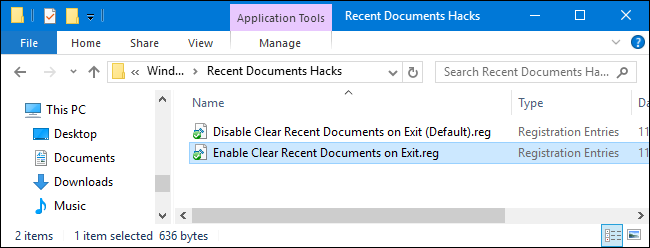
If you don’t feel like diving into the Registry yourself, we’ve created two downloadable registry hacks you can use. One hack enables the clearing of recent documents when you exit Window and the other hack disables it, restoring the default setting. Both are included in the following ZIP file. Double-click the one you want to use, click through the prompts, and then restart your computer.
如果您不想自己进入注册表,我们创建了两个可供下载的注册表黑客。 一个hack会在您退出Window时清除最近的文档,而另一个hack会禁用它,从而恢复默认设置。 两者都包含在以下ZIP文件中。 双击要使用的计算机,单击提示,然后重新启动计算机。
These hacks are really just the Explorer key, stripped down to the ClearRecentDocsOnExit value we described above, and then exported to a .REG file. Running the “Enable Clear Recent Documents on Exit” hack creates the ClearRecentDocsOnExit value and also sets that value to 1. Running the “Disable Clear Recent Documents on Exit (Default)” hack deletes the value, restoring the default setting of preserving the recent documents list when you exit Windows. And if you enjoy fiddling with the Registry, it’s worth taking the time to learn how to make your own Registry hacks.
这些hack实际上只是Explorer密钥,被精简为我们上面描述的ClearRecentDocsOnExit值,然后导出到.REG文件。 运行“在退出时启用清除最近的文档” hack会创建ClearRecentDocsOnExit值,并将该值设置为1。运行“在退出时禁用清除最近的文档(默认值)” hack会删除该值,恢复保留最新文档的默认设置。退出Windows时列出。 而且,如果您喜欢使用注册表,则值得花时间学习如何制作自己的注册表黑客。
专业版和企业版用户:使用本地组策略编辑器清除最近的文档列表 (Pro and Enterprise Users: Clear the Recent Document List with the Local Group Policy Editor)
If you’re using Windows 10 Pro or Enterprise, the easiest way to clear the recent documents list when you exit Windows is by using the Local Group Policy Editor. It’s a pretty powerful tool, so if you’ve never used it before, it’s worth taking some time to learn what it can do. Also, if you’re on a company network, do everyone a favor and check with your admin first. If your work computer is part of a domain, it’s also likely that it’s part of a domain group policy that will supersede the local group policy, anyway.
如果您使用的是Windows 10 Pro或Enterprise,则退出Windows时清除最近文档列表的最简单方法是使用“本地组策略编辑器”。 这是一个非常强大的工具,因此,如果您以前从未使用过它,那么值得花一些时间来学习它可以做什么。 另外,如果您在公司网络中,请给所有人一个帮助,并首先与您的管理员联系。 如果您的工作计算机是域的一部分,则它也很可能是域组策略的一部分,无论如何,该组策略将取代本地组策略。
In Windows 10 Pro or Enterprise, hit Start, type gpedit.msc, and press Enter.
在Windows 10 Pro或Enterprise中,单击“开始”,键入gpedit.msc,然后按Enter。
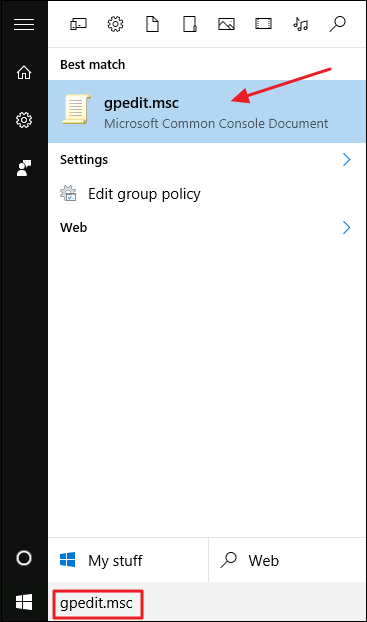
In the Local Group Policy Editor, in the left-hand pane, drill down to User Configuration > Administrative Templates > Start Menu and Taskbar. On the right, find the “Clear history of recently opened documents on exit” setting and double-click it.
在“本地组策略编辑器”的左侧窗格中,向下钻取到“用户配置”>“管理模板”>“开始”菜单和任务栏。 在右侧,找到“退出时最近打开的文档的清除历史记录”设置,然后双击它。
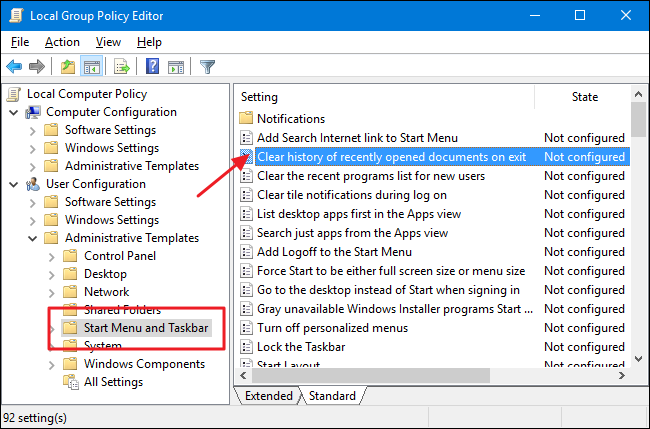
In the properties window that opens, select the Enabled option and then click OK.
在打开的属性窗口中,选择“启用”选项,然后单击“确定”。

You can now exit the Local Group Policy Editor. The next time you exit Windows, your list of recent documents should be cleared. If at any time you want to reverse the change, just follow the same procedure and set the “Clear history of recently opened documents on exit” setting back to Disabled or Not Configured.
现在,您可以退出本地组策略编辑器。 下次退出Windows时,应清除最近文档列表。 如果您想随时撤消更改,只需遵循相同的步骤,然后将“退出时最近打开的文档的清除历史记录”设置重新设置为“已禁用”或“未配置”。
翻译自: https://www.howtogeek.com/280745/how-to-clear-the-recent-documents-list-when-you-exit-windows/
linux退出文档命令





















 363
363











 被折叠的 条评论
为什么被折叠?
被折叠的 条评论
为什么被折叠?








